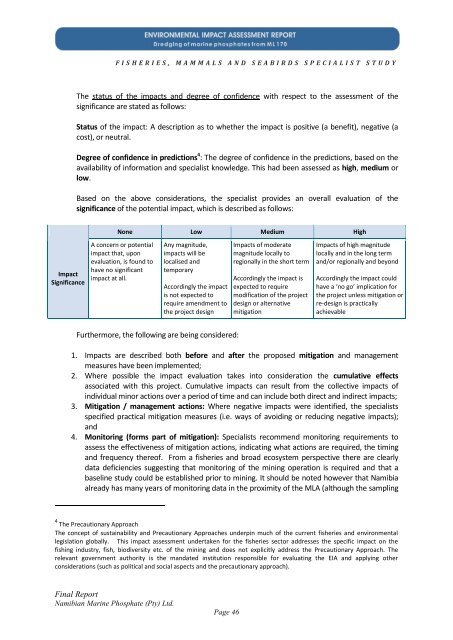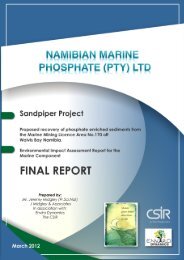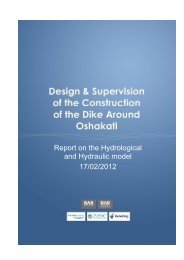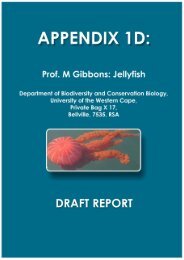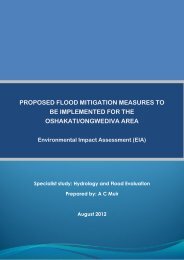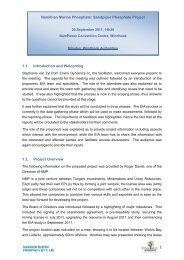Fisheries - Enviro Dynamics Namibia
Fisheries - Enviro Dynamics Namibia
Fisheries - Enviro Dynamics Namibia
Create successful ePaper yourself
Turn your PDF publications into a flip-book with our unique Google optimized e-Paper software.
Impact<br />
Significance<br />
F I S H E R I E S , M A M M A L S A N D S E A B I R D S S P E C I A L I S T S T U D Y<br />
The status of the impacts and degree of confidence with respect to the assessment of the<br />
significance are stated as follows:<br />
Status of the impact: A description as to whether the impact is positive (a benefit), negative (a<br />
cost), or neutral.<br />
Degree of confidence in predictions 4 : The degree of confidence in the predictions, based on the<br />
availability of information and specialist knowledge. This had been assessed as high, medium or<br />
low.<br />
Based on the above considerations, the specialist provides an overall evaluation of the<br />
significance of the potential impact, which is described as follows:<br />
Final Report<br />
<strong>Namibia</strong>n Marine Phosphate (Pty) Ltd.<br />
None Low Medium High<br />
A concern or potential<br />
impact that, upon<br />
evaluation, is found to<br />
have no significant<br />
impact at all.<br />
Any magnitude,<br />
impacts will be<br />
localised and<br />
temporary<br />
Accordingly the impact<br />
is not expected to<br />
require amendment to<br />
the project design<br />
Furthermore, the following are being considered:<br />
Page 46<br />
Impacts of moderate<br />
magnitude locally to<br />
regionally in the short term<br />
Accordingly the impact is<br />
expected to require<br />
modification of the project<br />
design or alternative<br />
mitigation<br />
Impacts of high magnitude<br />
locally and in the long term<br />
and/or regionally and beyond<br />
Accordingly the impact could<br />
have a ‘no go’ implication for<br />
the project unless mitigation or<br />
re-design is practically<br />
achievable<br />
1. Impacts are described both before and after the proposed mitigation and management<br />
measures have been implemented;<br />
2. Where possible the impact evaluation takes into consideration the cumulative effects<br />
associated with this project. Cumulative impacts can result from the collective impacts of<br />
individual minor actions over a period of time and can include both direct and indirect impacts;<br />
3. Mitigation / management actions: Where negative impacts were identified, the specialists<br />
specified practical mitigation measures (i.e. ways of avoiding or reducing negative impacts);<br />
and<br />
4. Monitoring (forms part of mitigation): Specialists recommend monitoring requirements to<br />
assess the effectiveness of mitigation actions, indicating what actions are required, the timing<br />
and frequency thereof. From a fisheries and broad ecosystem perspective there are clearly<br />
data deficiencies suggesting that monitoring of the mining operation is required and that a<br />
baseline study could be established prior to mining. It should be noted however that <strong>Namibia</strong><br />
already has many years of monitoring data in the proximity of the MLA (although the sampling<br />
4 The Precautionary Approach<br />
The concept of sustainability and Precautionary Approaches underpin much of the current fisheries and environmental<br />
legislation globally. This impact assessment undertaken for the fisheries sector addresses the specific impact on the<br />
fishing industry, fish, biodiversity etc. of the mining and does not explicitly address the Precautionary Approach. The<br />
relevant government authority is the mandated institution responsible for evaluating the EIA and applying other<br />
considerations (such as political and social aspects and the precautionary approach).


